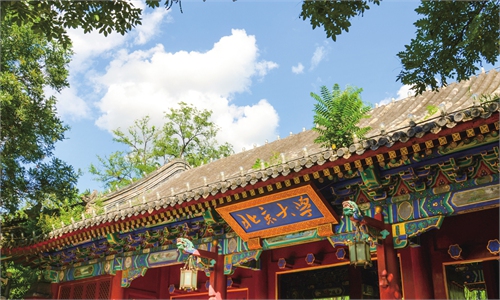ARTS / CULTURE & LEISURE
1,000-year-old texts restored and preserved at Potala Palace in Xizang Autonomous Region
Pearl on the roof of the world

The Potala Palace in Lhasa, Xizang Autonomous Region Photo: VCG

The roofs of the Potala Palace Photo: VCG
Editor's Note:Over the past decade, enhanced efforts to protect and restore cultural relics in Southwest China's Xizang Autonomous Region have been carried out thanks to firm support from the Central Government. More ancient treasures have been excavated and documented, helping piece together regional and national history and make clear the close connection that has existed between the Central Plains and the plateau since ancient times.
In this series about Xizang's cultural relics, the overall picture of conservation efforts and their achievements will be introduced, while the Potala Palace, one of Xizang's symbols, will be covered as a typical example of protecting and restoring cultural relics through high technology.
Shelf by shelf, scroll by scroll, and page by page, Chinese researchers have archived more than 12 million folios of 3,499 ancient books and documents dating back to the 7th century at the Potala Palace in the Xizang Autonomous Region.
The Potala Palace is a veritable treasure house of Tibetan ethnic literature and history. Among the nearly 40,000 precious ancient texts belonging to different ethnic groups such as Han, Manchu, Mongolian and Tibetan, the palm-leaf manuscripts made from dried palm leaves are a major highlight.
How many ancient documents are there in the collection at the Potala Palace? What exactly do these texts record? Chinese archaeologists have been seeking the answers to these questions.
These ancient texts have been part of a preservation and restoration project that started in 2018 with 300 million yuan ($42 million) in funding from the Central Government. The project is expected to be a 10-year process of protection, repair, digitization and exhibition.
At a press conference held on Saturday by the Cultural Heritage Administration of the Xizang Autonomous Region, officials briefed the latest progress of the project, noting that the overall plan for the project has been completed and that investigation of ancient texts, especially palm-leaf manuscripts, have been carried out.
Defeating time
Covering 41 hectares - roughly the size of 55 football fields - atop a craggy hill in the heart of Lhasa, the Potala Palace, which was built in the 7th century and included on the UNESCO World Heritage List in 1994, is home to large quantities of precious books written with gold, silver and turquoise on materials such as wood, brocade and pattra leaves.
Walking into the buildings of the palace, visitors can feel that the cultural relics, including ancient books and documents, are part of the palace's furnishings, which have been preserved almost untouched for thousands of years.
Among the ancient texts, the palm-leaf manuscripts are one of the most significant cultural heritages.
Birgit Kellner, director of the Institute for the Cultural and Intellectual History of Asia at the Austrian Academy of Sciences, noted that the palm-leaf Sanskrit Buddhist texts at temples and institutes in Xizang, including the Potala Palace, have priceless research value as most of them are surviving rare editions or even the only existing copy.
Besides manuscripts, the palace also collects the Tibetan Kagyur of the Tripitaka, or the Discourse of Buddha. Dating back to 1410, the work contains writings by senior monks, books on medicine, history and a vast amount of the Tibetan Buddhist canon.
To better preserve such precious ancient texts, many kinds of high technology have been used during research, according to the China National Cultural Heritage Administration.
The team carrying out the conservation project has furthered research into preventing damage to ancient books by insects, investigated the DNA of palm-leaf texts and tested of durability of Tibetan paper.
Researchers also successfully developed electrostatic adsorption non-destructive extraction device for the palm-leaf manuscripts. Considering of delicate nature of these ancient texts, the environment of the palace is constantly monitored using technology such as Building Information Modeling.
A digitalization project to preserve this cultural heritage has also been carried out. Several Buddhist texts have been scanned and archived into a database for ancient books.
Modern significance
Ancient books are not only treasure houses for ancient thought and the crystallization of the wisdom of sages, but also important carriers of the inheritance of a civilization and the collective memory of a nation.
Zhang Yiwu, a professor of cultural studies at the Peking University, told the Global Times that China's soft power is rooted in its excellent traditional culture, especially the concepts found in ancient books.
Because of their profound meaning, Chinese researchers spare no effort to protect and explore the value of ancient texts collected at the Potala Palace.
Over the next decade, the project plans to explore the protection, restoration, research, display and management of ancient books and documents, while striving to combine modern science and technology with traditional preservation methods to create a complete protection and utilization system in line with the actual situation at the palace.






